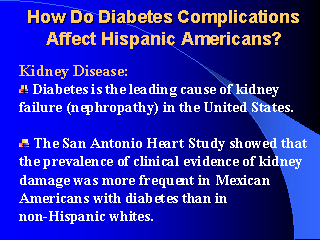|
|
|
|
front |1 |2 |3 |4 |5 |6 |7 |8 |9 |10 |11 |12 |13 |14 |15 |16 |17 |18 |19 |20 |21 |22 |23 |24 |25 |26 |27 |28 |29 |30 |31 |32 |33 |34 |review |
 |
Diabetes is the No. 1 cause of kidney failure in the United States, accounting for more than 40 percent of new cases of end-stage renal disease (ESRD), or total kidney failure, each year. People with ESRD require regular dialysis or a kidney transplant to stay alive. The links between diabetes and kidney failure are not new, but as the incidence of diabetes increases, the number of ESRD cases also has increased dramatically. Each year, 120,000 Americans permanently lose their kidney function as a result of diabetes. Not everyone with diabetes develops kidney disease. Factors that can influence development include genetics, blood glucose control, and blood pressure. The better a person keeps diabetes under control, the lower the chance of getting kidney disease. High blood pressure should also be kept under control. The healthier the blood pressure, the healthier the kidneys will be. More than 30 percent of people with type1 diabetes will one day have kidney disease, compared with perhaps 10 percent of people with type 2 diabetes. People with type 1 diabetes have 15 times the risk of ESRD as those with type 2 diabetes. The longer a person has diabetes, the higher the risk of kidney disease-up to a point. After 40 years with diabetes, if a person does not yet have kidney disease, he or she probably never will. Research suggests that high levels of blood sugar and hypertension (high blood pressure) increase the risk of people with diabetes developing ESRD. Hypertension is a particularly dangerous complication of diabetes because the regulation of blood pressure is a key function of the kidney. As hypertension progresses and damages the kidneys, the organs are less able to do the job of controlling blood pressure, triggering a dangerous cycle ending in severe kidney damage. The combined effect of continued hyperglycemia and elevated blood pressures results in acceleration of diabetic nephropathy and retinopathy. Men are 50 percent more likely to get kidney disease than women. Native Americans are seven times more likely to have kidney disease than other ethnic groups. Other ethnic groups at greater risk are African Americans (three to four times the risk of non-Hispanic whites) and Mexican Americans. |